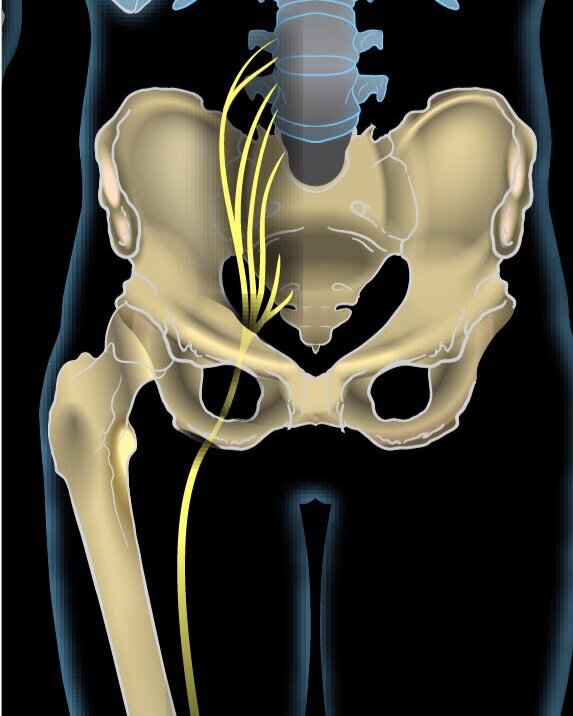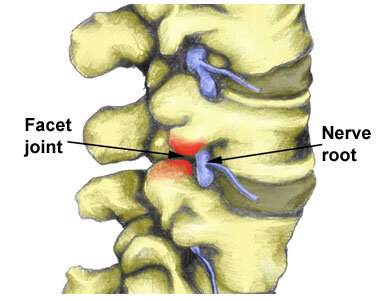Differential Diagnosis- Sciatica
Do you have discomfort in your leg and wonder if it’s Sciatica? In this post I’ll discuss some tests to differentiate between Sciatica and other diagnoses.
First, let’s nerd out a bit:
The Sciatic nerve is a collection of nerves that start at your low back and come together to run down the back side of your leg. The nerve ‘root’ as it’s called exits between L4 and L5 (the 4th and 5th lumbar vertebra) as well as S1, S2, and S3 (sacral segments) respectively. Each of these nerve roots can get irritated by something that closes down the hole where the root exits. Some examples of things that can close down the area where the nerve exits are herniated disc and or a chemical response from it, arthritis/ stenosis, or a bone spur. This narrowing of the hole where the nerve comes out causes the nerve to get irritated, or completely compressed, and then you feel symptoms in the corresponding region of your leg. Here is a photo of the Sciatic nerve.
The sciatic nerve runs down the back of your leg and then has several branches that run down to your foot/ calf. Physical Therapists have “special tests” that we use to differentiate which tissue in the body is injured. These are some special tests for nerve involvement:
sensation- Numbness and tingling are two symptoms that describe nerve pain. Physical Therapists will test Vibration, light touch, sharp touch, and hot/ cold which all give different information about the nerve root health.
strength- If you start to feel like your leg or foot is getting weak this could be a sign of nerve involvement because the nerve innervates the muscle. Imagine electricity to a light bulb. If the signal is cut off the light bulb could flicker or even go completely off. This would manifest in some changes in strength or fatigue-able weakness in a muscle in your leg.
reflexes- The patella, achilles, and hamstring reflex all are representations of nerve health and can be normal, increased, or decreased suggesting either a normal, irritated, or compressed sciatic nerve.
Cram’s test- https://www.youtube.com/watch?v=6fLeqG41qJ8
Nerve tension- This is a test to put stretch through the nerve originating at your back to see if it is inflamed. This tension can be placed in different directions to test different branches of the sciatic nerve and confirm or rule out nerve involvement. The photo below is of the "Slump test” which is an example of one of the nerve tension tests.
The special tests above are to confirm or rule out the sciatic nerve as being irritated or compressed. A PT will then use other special tests to determine what is causing the nerve to be affected (the disc, stenosis, bone spur etc). Treatment of the underlying cause is essential to healing.
What else could pain in your leg be? Here are a few examples:
Muscle pain- Hamstring strain/ calf strain
Special tests for muscle:
Resisted testing, stretch, and palpation.
Basically the muscle will hurt to use it (doing a calf raise or a hamstring curl), it will hurt to stretch it, and it will hurt when you poke at it or massage it.
If it doesn’t hurt with ALL THREE of these tests then it’s not the muscle.
Facet joint referral
The facet is a joint in your low back that is located close to where the sciatic nerve exits. Usually if your pain is above the knee it’s more facet, if you have pain all the way down to the foot it is likely the nerve.
Special tests for facet:
Compressing the facet with certain motions of the spine will reproduce the pain in your low back , hip, or leg. This special test is called a “quadrant” test and can be performed by a Physical Therapist to rule out the facet as the cause of your pain.
Other nerves than the Sciatic:
A peripheral nerve- A nerve can be entrapped further down the leg instead of at the nerve root.
Femoral nerve or Obturator nerve- Other nerves that originate in the lumbar spine and run down the leg and can cause similar pain to the sciatic nerve but in a different area.
Cutaneous nerve- A nerve that supplies the skin and can produce a similar pain as sciatic but would only respond to special tests for sensation but not strength or reflexes.


